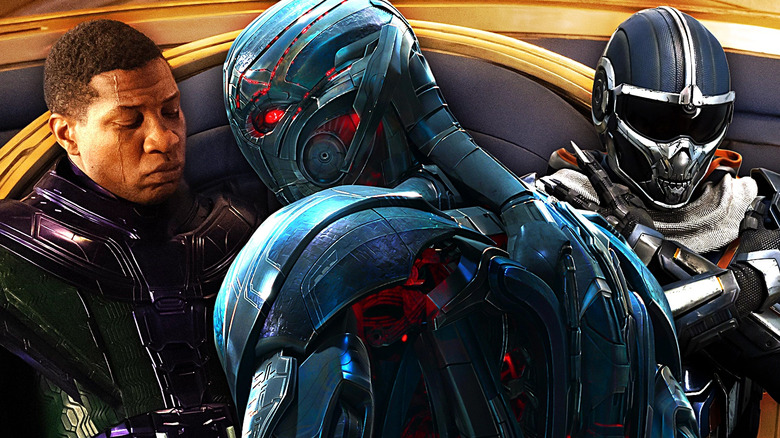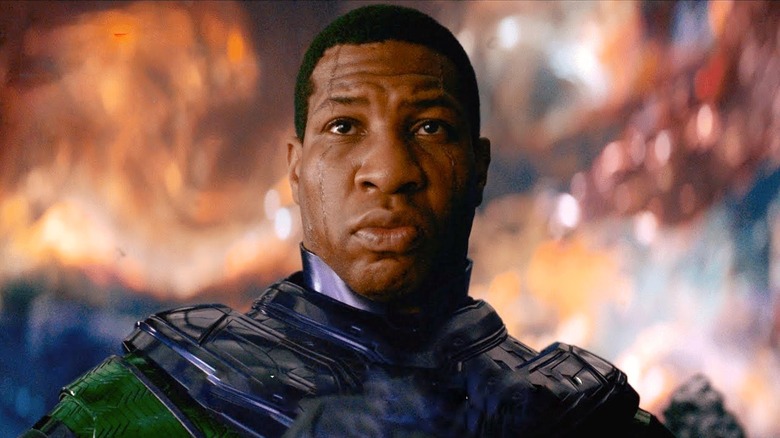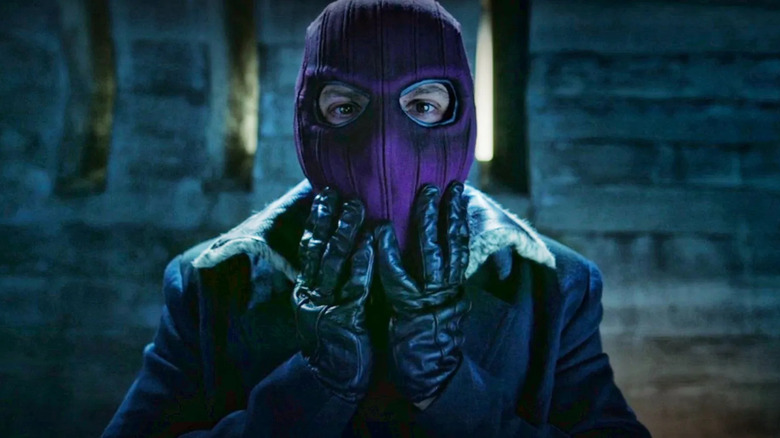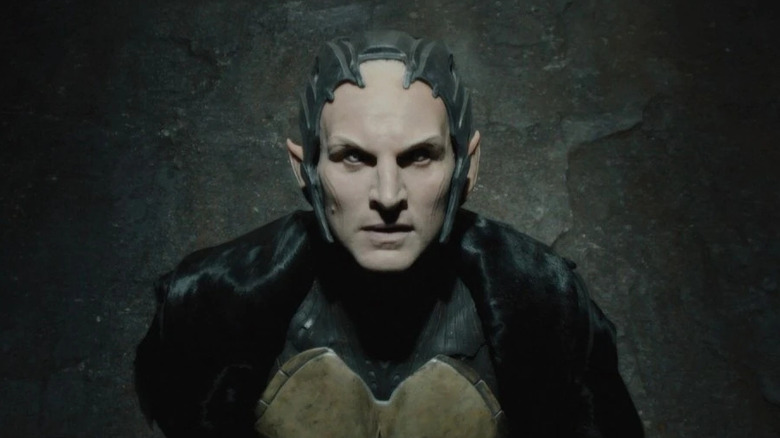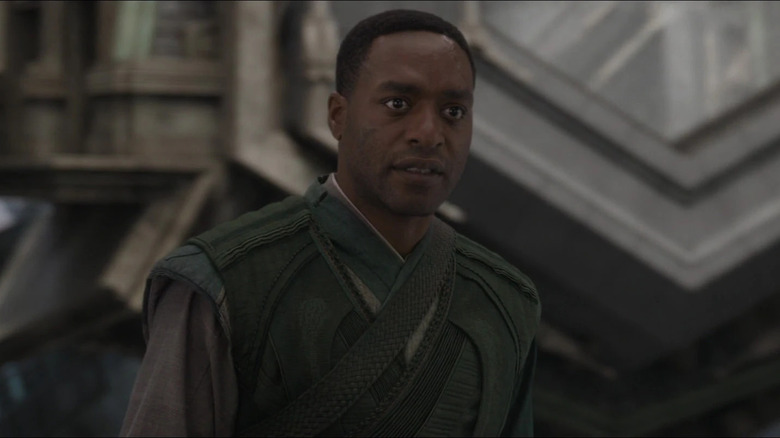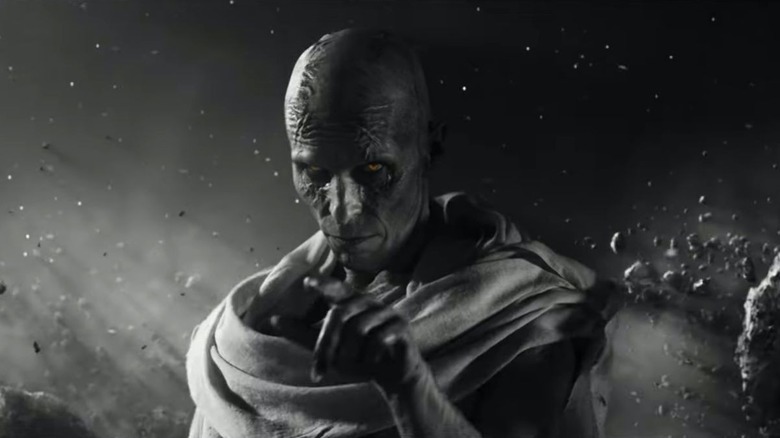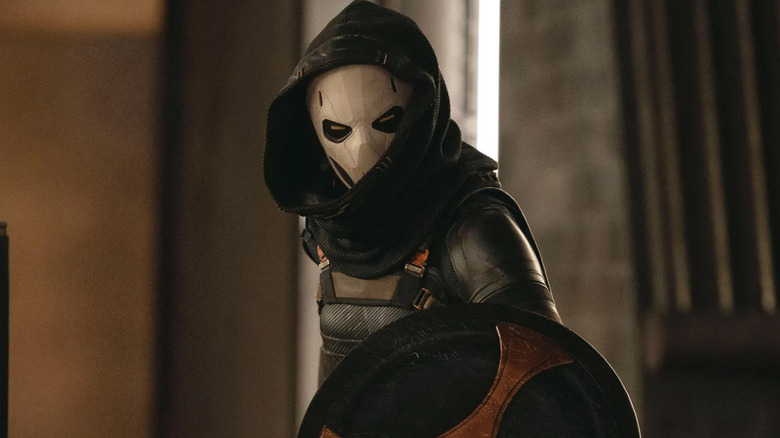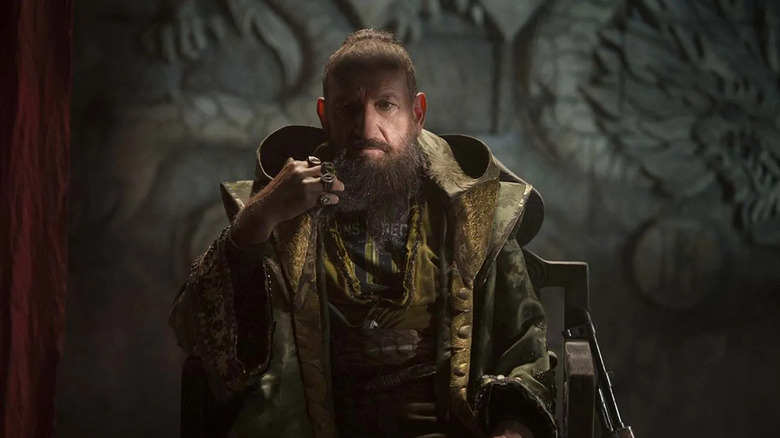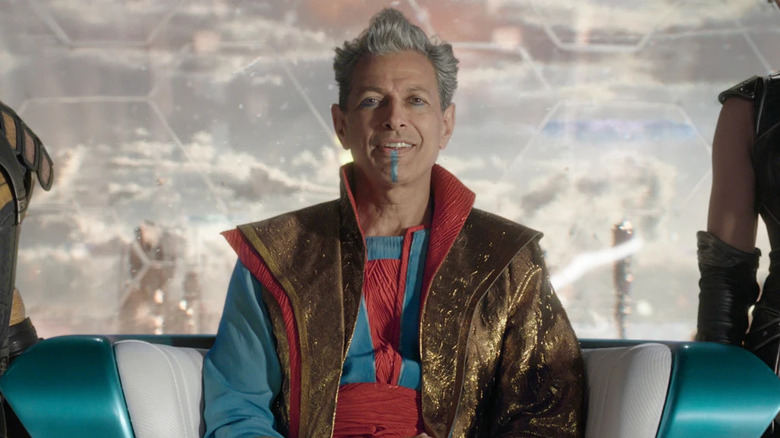10 Marvel Villains Whose Comic Book Origins Overhyped Their Role In The MCU
With the villain-centric "Thunderbolts*" (or "*The New Avengers," for the cool kids) and the arrival of Lewis Pullman's Bob Reynolds (aka The Sentry), fans may be asking themselves if Marvel Studios is finally ready to put their infamous "villain problem" to bed.
Since the early years of the Marvel Cinematic Universe, the studio has struggled to adapt the weird antagonists featured in the comics for their grounded world, the end result being muted video-game-like baddies with interchangeably tragic backstories. This apparent aversion to the comics has led to a wide gulf between the impactful, often existentially-threatening villains fans expect and the easily dispatched bad guys they get. At this point, they know better than to get too excited about the introduction of any character, even when their comic book origins understandably overhype their potential role in the MCU.
Here are 10 Marvel villains whose comic book origins overhyped their role in the MCU.
Kang the Conqueror
After "Avengers: Infinity War" and "Avengers: Endgame" turned Thanos into one of the most popular villains in film history, Marvel had the difficult task of selecting and casting their next big bad. This character and actor would, in many ways, be responsible for five years of a multi-billion dollar enterprise. The choice of Jonathan Majors to play Kang the Conqueror was inspired at the time, and his work in both "Loki" and "Ant-Man and the Wasp: Quantumania" were lauded, receiving the most positive buzz the MCU has had since the Infinity Saga. Of course, no one could have predicted that, shortly after the latter feature, Majors would be convicted of misdemeanor assault and harassment for abusing his then girlfriend, who was also one of his co-workers at Marvel.
Unsurprisingly, Marvel fired Majors and ultimately made other plans. But while the MCU did their best to forget Kang ever happened, the comics didn't. Kang has been a key villain in "Avengers" comics as early as the 1960s and as recently as 2025. Stories like "Kang Dynasty" or "Avengers Forever" are not only some of the best Kang comics fans should read, but unique adventures that are as weird as they are ambitious. Had the studio stayed the course with Kang by simply recasting him (an option they may not have had, depending on the terms of Majors' contract), these are surely the sorts of millenia-spanning sci-fi epic comics that Marvel would've been sourcing for "Avengers: The Kang Dynasty." Because of Majors' actions and Hollywood politics, however, we are left with a few constrained appearances that promised more than they'll ever deliver.
Baron Zemo
Speaking of rare high points in the post-"Endgame" MCU, the return of Daniel Brühl's Zemo was a welcome surprise from the otherwise middling Disney+ series "The Falcon and the Winter Soldier." Brühl gives Zemo such charisma and gravitas that it's hard not to be swept up by his mission to rid the world of superheroes. It doesn't hurt that he also happens to be a heck of a dancer too. Similar to the Mandarin's revival in "Shang-Chi," this re-introduction of Zemo allowed Marvel Studios, newly emboldened at the peak of their popularity, to bring the character closer to the comic book counterpart we never got to see in "Captain America: Civil War."
As well as Brühl plays the tragedy of a man who lost everything to the devastating destruction of Sokovia during the events of "Avengers: Age of Ultron," Zemo is both visually and narratively unremarkable. He's effectively indistinguishable from the antagonist of a spy-thriller, which only serves to send him drifting into the background of a story that, while populated by an overwhelming amount of costumed heroes with more colorful backstories, relies on him to generate tension and thematic complexity.
In the comics, Baron Zemo is a major antagonist with the resources, motivation, and indeed superpowers to take on the Avengers, the X-Men, and the Fantastic Four. He's not the lone operator you see in "Civil War," but one of the focal points of the entire Marvel Comics underground criminal network, who plays major roles in organizations like Hydra, the Masters of Evil, the Secret Empire, and the original Thunderbolts. When he entered the MCU, he could've brought the whole underworld with him. And though we see flashes of this potential in the aforementioned Disney+ series, it seems unlikely now that Zemo will ever be as spectacularly evil as he is in the comics.
Crossbones
Also introduced in earnest in "Captain America: Civil War" was Frank Grillo's Crossbones, a mercenary who has a personal beef with Steve Rogers (Chris Evans). The preceding "Captain America: The Winter Soldier" had teased the character, with Grillo debuting as SHIELD-slash-undercover Hydra agent Brock Rumlow. During the final battle of the 2014 sequel, Rumlow is left for dead in SHIELD's crumbling headquarters, but is shown to have survived with serious lasting injuries. He's killed for good in the opening scene of "Civil War" after he attempts to kill Captain America with a bomb vest.
Aside from his gauntlets that allow him to somewhat mimic super strength, the Crossbones of the MCU has no unique abilities and is functionally no different from any of the nameless Hydra agents Cap and co. dispatch with ease. In the comics, the character is a hulking one-man army at the peak of human physical potential who stands as one of the deadliest mercenaries in the world, as well as one of Captain America's most recognizable recurring rogues alongside Red Skull, Arnim Zola, and Baron Zemo.
The fact that he's killed immediately after we finally get to see him anywhere close to his comic book potential is a massive bummer, even if there was simply no room for him to be brought back as an antagonist for Steve in the MCU. The world of the "Captain America" series feels so much smaller without him, robbed of a personally motivated villain that could have been reworked for further use.
Malekith
Christopher Eccleston's Malekith gets a lot of hate from MCU fans. Unfortunately, it's well-deserved.
Though the "Doctor Who" actor gives a perfectly fine performance (and is by no means responsible in any capacity for how dull the leader of the dark elves comes across in "Thor: The Dark World") he's an interchangeable, laser-shooting, catchphrase-shouting, macguffin-motivated bad guy that kicked off Marvel's villain problem for real. He's without question the worst Phase 2 Marvel villain, one of, if not the worst villain overall, and one of the most disappointing characters in the entire franchise. He's such a terrible, chalky character that Benedict Cumberbatch turned down the offer to play him immediately, thankfully choosing to hold out for something better.
The comics lend Malekith more credibility as a character in design alone, drawn like a proper fantasy foe with a more interesting costume and color scheme. More than that, the Malekith of comics old and new — from Walt Simonson's seminal "Thor" run to the more recent work of Jason Aaron — is an eccentric schemer and magical practitioner, rather than a boringly stoic military general who marches around speaking in monotone to his clone-like CGI army. He's also something of a diplomat, often allying himself with mythical creatures who themselves bring unexpected and exciting elements to his encounters with Thor. This version of Malekith could have still been used to bring greater depth to Tom Hiddleston's Loki, showing the audience what a true and irredeemably cruel enemy of Asgard looks like.
Baron Mordo
When Baron Mordo (Chiwetel Ejiofor's supporting antagonist from the original "Doctor Strange" film) first appeared in the MCU, it was actually fairly likely that he would become an overarching villain in the series similar to his comic book counterpart. Broadly speaking, though Dormammu is mostly considered to be Doctor Strange's arch-nemesis, Mordo is his most consistent and equally matched adversary.
When the film begins, Mordo is a senior student at Kamar Taj serving the Ancient One (Tilda Swinton). However, once he discovers that she has been taking advantage of forbidden magic from the Dark Dimension, Mordo begins to question the responsibility of allowing anyone to possess such awesome power. He's last seen in the main plot walking away from Stephen Strange and Wong (Benedict Wong), and is seemingly shown in the post-credits scene to be traveling around the world to revoke the magical gifts of those he deems unworthy. This was a pretty perfect set-up for Mordo to be used in future films as a personal antagonist for Stephen. Sadly, it seems like plans have changed drastically since the film premiered almost a decade ago.
All of the writers of the original "Doctor Strange" film as well as director Scott Derrickson departed the sequel project, with writer Michael Waldron and director Sam Raimi stepping in for what would ultimately be "Doctor Strange in the Multiverse of Madness." This change in the creative line-up (coinciding with the ramping up of Marvel Studios' multiversal hyperfixation and the desperate production of various Disney+ shows) meant that Mordo's story had to be pushed aside, likely forever, in favor of introducing Elisabeth Olsen's Wanda Maximoff / Scarlet Witch as the new sequel villain. In fact, one draft of the story had Maximoff killing Mordo in an early scene. Mordo does return, but as a multiversal variant, not the vengeful sorcerer we love from the comics and were seemingly promised at the end of the previous film.
Gorr, the God Butcher
As we mentioned earlier, Jason Aaron is arguably the definitive contemporary "Thor" writer in comics. Of all his contributions to the Asgardian's mythos, his most thrilling was Gorr the God Butcher, a magnificent villain he created with artist Esad Ribic. Like the character seen in "Thor: Love and Thunder" (played with as much integrity as possible by Christian Bale), Gorr is an alien who loses faith in the concept of gods as a result of the cosmic cruelty he had been subjected to throughout his life despite his religion. At this point, the two versions of the character begin to differ greatly.
In addition to sporting a more striking character design than Bale's, Aaron and Ribic's Gorr could've laid the groundwork for the further expansion of the Marvel Universe by way of his origin. After rejecting his faith and dedicating his life to slaying the deities who neglected him and his family, comic book Gorr meets the symbiote god Knull, who bestows upon him the god-slaying weapon All-Black the Necrosword. This is the same character who was played by Andy Serkis in "Venom: The Last Dance," and was teased as a major universal threat throughout the film.
Because Sony has the rights to Knull and everything else tangentially related to Spider-Man, using Gorr's origin story was probably never a real possibility for "Thor: Love and Thunder." As a result, he's only slightly more memorable than Malekith or Colm Feor's Laufey from the first "Thor" film.
Ultron
When Marvel Studios named their second "Avengers" film after the then-recent 2013 comic book event "Age of Ultron," they were basically setting fans up for disappointment from the start. There's a lot to love about the character in the 2015 sequel, from his evolving design to the surprisingly charismatic performance from James Spader. But though the effects of "Avengers: Age of Ultron" were felt throughout the rest of the Infinity Saga (both in front of and behind the camera, as the box office results taught Marvel a lesson they unfortunately learned too well), the film itself was strangely contained.
Like Kang the Conqueror, Ultron is the sort of villain that probably needs to appear in more than one film to achieve the effect he has in the comics. The "Age of Ultron" storyline, for example, doesn't just see him attack a city in an attempt to wipe out humanity in a matter of a few weeks. He fully conquers Earth and subjugates the whole of humanity to his will, forcing them to forge a resistance to stop him. In the context of the Marvel Cinematic Universe, he's just that thing that happened before Thanos came along. The average citizen in the MCU doesn't even seem to care about Ultron at all and instead vaguely blames the Avengers for everything that went down — and even that has been all but nullified by subsequent heroics.
Taskmaster
Contains spoilers for "Thunderbolts*, so beware"
Call recency bias all you want, but there's something so uniquely heartbreaking about the way Marvel Studios used and discarded Taskmaster. Getting rid of such an iconic comic book character so unceremoniously would have been disappointing enough, but it's the way they had already mangled the character beyond recognition that makes her one of the most upsetting characters in the MCU.
Played by Olga Kurylenko in "Black Widow" and (for like two seconds) "Thunderbolts*," the MCU Taskmaster is a former Red Room agent who is cybernetically upgraded against her will. She's basically a cyborg, and everything potentially special or interesting about her (right down to her photographic reflexive combat memory, the character's defining trait in the comics) comes from implants rather than skill.
Throughout her first film appearance the character has no agency or personality, and only the bare bones of a history. In her second, her role was greatly reduced during the development process until the director ultimately decided to kill her off in one of the film's opening fight scenes, a decision made essentially to trick the audience into thinking the rest of the movie would have physical stakes. (Hilariously, this "shocking" twist was guessed by fans before the movie was released.)
A villain like Taskmaster (originally a man in the comics) is made imposing by the unique agency his abilities afford him. He isn't just some mercenary, but a master combatant feared by anyone without superpowers and revered by those who seek him out as a teacher. It's also worth pointing out that a comic-accurate Taskmaster would have been a much better villain for a street-level team like the Thunderbolts / New Avengers, as she would have still been capable of taking them all on at once without being an unbeatable CGI damage-sponge. Sadly, she seems to be just another example of Marvel seeing a villain as an action figure and promotional material, rather than a real character.
The Mandarin
Longtime fans of the Marvel Cinematic Universe are already well aware of the Mandarin's infamous history in the comics, at least broadly, as a result of how directly it impacted the disappointing adaptation of the character we got in "Iron Man 3." The character — a somewhat unavoidable staple of "Iron Man" comics, arguably being the closest thing Tony Stark has to an arch-nemesis (aside from himself) — had been hinted at in the first "Iron Man" film, and was announced by director Jon Favreau as the main villain of the third as early as 2010, almost two years before "The Avengers" had even been released. Though the studio understood Favreau's desire to honor the comic book lore, they were understandably terrified at the idea of tackling a character who was originally written as a racist stereotype of Chinese people.
In the end, the studio and director Shane Black opted to avoid controversy by avoiding his comic book origins entirely, instead initially portraying him as the fake leader of a terrorist organization that allowed A.I.M. director Alrdich Killian (Guy Pearce) to gain power by essentially capitalizing on Islamophobia and American jingoism. This was an alright enough side-stepping of the issue, but was undeniably an underwhelming use of a character who normally carries a lot of weight in "Iron Man" stories. In Matt Fraction and Salvador Larroca's "Invincible Iron Man" series from the late-2000s-early-2010s, they were even able to rework the Mandarin significantly so that he could be a major antagonist without being as harmful (there's still some aspects that haven't aged well from that run).
When the character was retconned in "Shang-Chi and the Legend of the Ten Rings" almost a decade later, it felt like Marvel was able to have their cake and eat it too. Tony Leung and co-writer and director Destin Daniel Cretton made the character compelling and empathetic, and he remains one of the best MCU villains of all time. But just when the studio finally made the Mandarin a better character than he debatably had any right to be, they wrote him out of the universe, robbing fans of the chance to see him have the impact he did in the comics.
The Grandmaster
Not to be confused with a different Tony Leung character, our last pick for this list is quietly the most glaring example of the MCU throwing the comics out the window — and, in some regards, the character in question is better off for it. Though the Grandmaster in the comics is not offensive like the Mandarin, the role he plays is arguably less fun than what we see in Taika Waititi and Jeff Goldblum's take on the character in "Thor: Ragnarok." Rather than merely a vaguely immortal ruler of a junk planet and purveyor of gladiators, Grandmaster is a capital E Elder of the Universe, a being of such immense power and influence that he rarely goes up against anyone that isn't a universal threat. He even fought Death herself once.
Waititi reduces Grandmaster greatly for Ragnarok, which allows Goldblum to shine as a whimsical and, in the grand scheme of things, harmless secondary foe that contributes to the film's unique sense of humor. In other words, it's hard to argue that "Ragnarok" or the greater MCU would be improved by having him be portrayed as a serious all-powerful cosmic overlord, whose desires lie in unrelatable schemes of conquest rather than bizarre quirks and petty earthly pleasures. He proves that, while looking toward the comics might prove useful as Marvel continues to struggle to create compelling villains in their films, what's best for the story is ultimately always what's best for the character.
